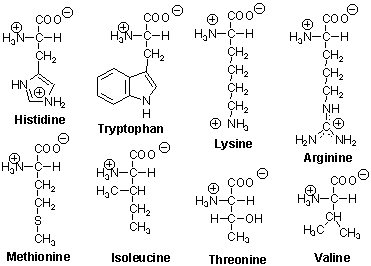
Written by Harold B. White
11/02
C-647 BIOCHEMICAL EVOLUTION,
FALL 2002
Final Group Research Assignment
 |
Written by Harold B. White
11/02
Final Group Research Assignment |
Selection for Lipogrammatic Proteins?
How important are each of the 26 letters in our alphabet? Could we dispense with "x" or "z"? What about "e" or "s" that we use a lot more? The French writer, Georges Perec (1936-1982), as a type of discipline and word play, wrote the lipogrammatic novel La Disparition avoiding the letter “e.” How constraining is this? (Two consecutive letters in the alphabet are not used in this problem statement.) What if we reduced usage of some letter to 50% of normal?
In a way, amino acids are to proteins as letters are to language. There are twenty common amino acids that are strung together in proteins. Different orders have different meaning. While it may seem pointless to dispense with a letter in writing, there are situations where selection for fewer of a particular amino acid might enable certain proteins to function better, for example, the enzymes involved in amino acid biosynthesis.
Typically in autotrophic microorganisms, each amino acid operon is repressed by its respective amino acid. Thus, for example, if histidine is available, the organism does not need the enzymes of histidine biosynthesis and they are not made. However, when histidine concentrations drop, transcription of the genes in histidine operon is favored and synthesis of the enzymes in the histidine biosynthetic pathway increases. Because histidine is scarce when the organism needs to synthesize it, one would predict that the enzymes for histidine biosynthesis would be synthesized faster to the extent that they did not contain histidine. One can hypothesize that selection would favor mutations that replaced histidine with other amino acids and disfavor mutations to histidine codons. Similar arguments apply for the enzymes of each amino acid biosynthetic pathway. But is this true?
Your group may test this hypothesis in any way you want for a particular amino acid; however, your manuscript, due December 11, must present relevant data, provide an in depth analysis, and come to conclusions. This assignment will display your ability to define a problem in biochemical evolution, access relevant information in genome databases, construct logical arguments, and rule out other hypotheses.
Your final report worth 10% of your course grade should have the form of a co-authored scientific paper. It should have an informative title, an abstract summarizing the findings and their importance, a short introduction, a methods section, a results section with original tables and/or graphs, and a discussion and conclusion section, followed by cited references.
To my awareness, this exercise has never been done. Therefore,
your observations and conclusions will be new. It is conceivable that these
reports, if well done, could be the basis for an actual scientific publication.